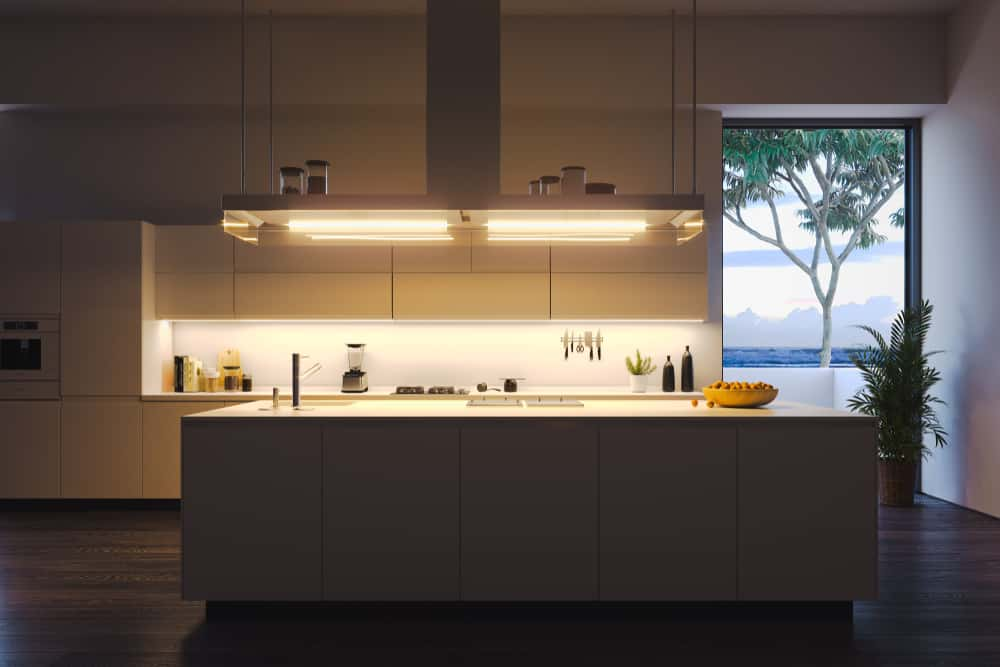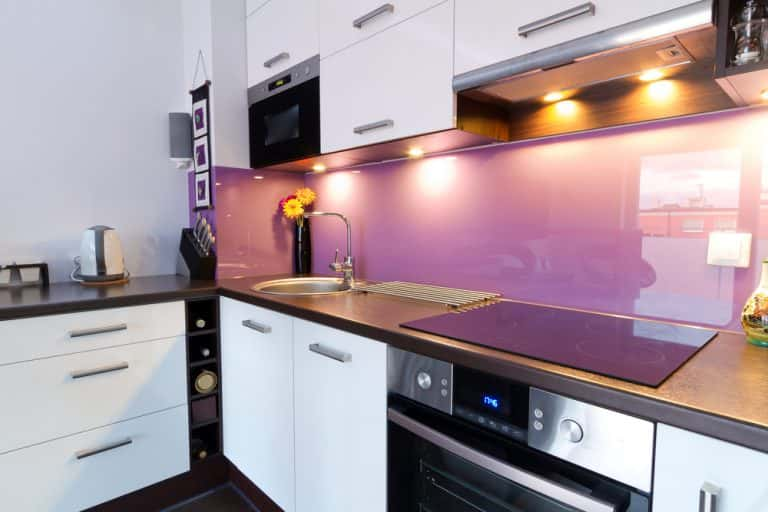Not getting enough natural light in the kitchen? Do you feel like your eyes are strained while preparing a meal? This is a common problem that many homeowners face, especially those with small kitchens and only a small window or two. Our experts have spilled the beans on the different types of kitchen lights available and how they are used to illuminate a kitchen beautifully, making it feel warm and inviting as well.
1. General Lighting Ideas for Kitchens
The first and possibly the most crucial kind of lighting you need is the recessed light. Recessed lights are excellent for general lighting but can also be used over task areas in kitchens. You could get a dimmer switch to control how bright you want the room to be when you are not cooking, for example.
If you don’t have a false ceiling in your kitchen, you may go for wall-mounted light fixtures, which do a similar job of uniformly distributing light in the room. Depending on the size of your kitchen, you can install a light fixture in the centre of the kitchen or two light fixtures at opposite ends of the kitchen.
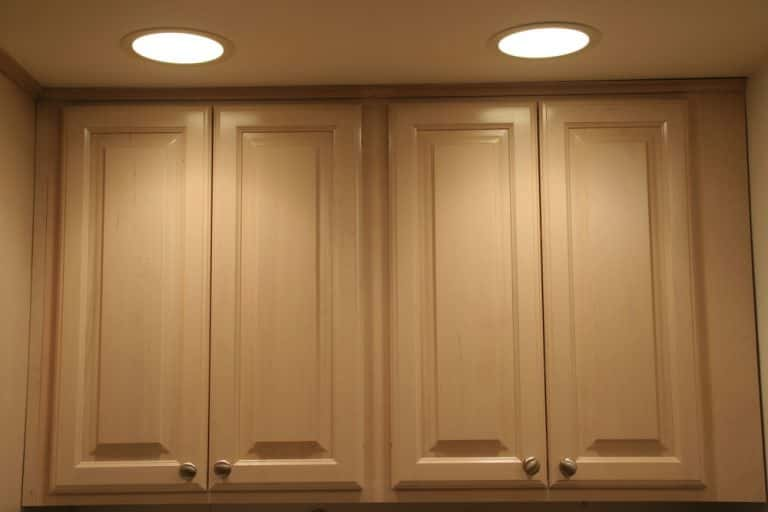
2. Pendant Lighting for Kitchen Islands
Pendant lighting for kitchens is often considered to be a decorative element that adds style, colour and a focal point to a kitchen. They have regained popularity in recent years and are usually installed over the peninsula or island in twos or threes. You can choose pendant lights in many shapes, sizes and materials. The metallic fixtures are an architectural element that adds character to the kitchen. Pendant lights look best in sets, and the number really depends on the length of the counter.
Since pendant lights hang down from the ceiling, they need to be installed in areas where people don’t walk (unless your kitchen has a super tall ceiling) to avoid getting in the way – roughly 30-34 inches above the counter. Since they hang low, it’s also easier to see the dust that collects – which means higher maintenance.
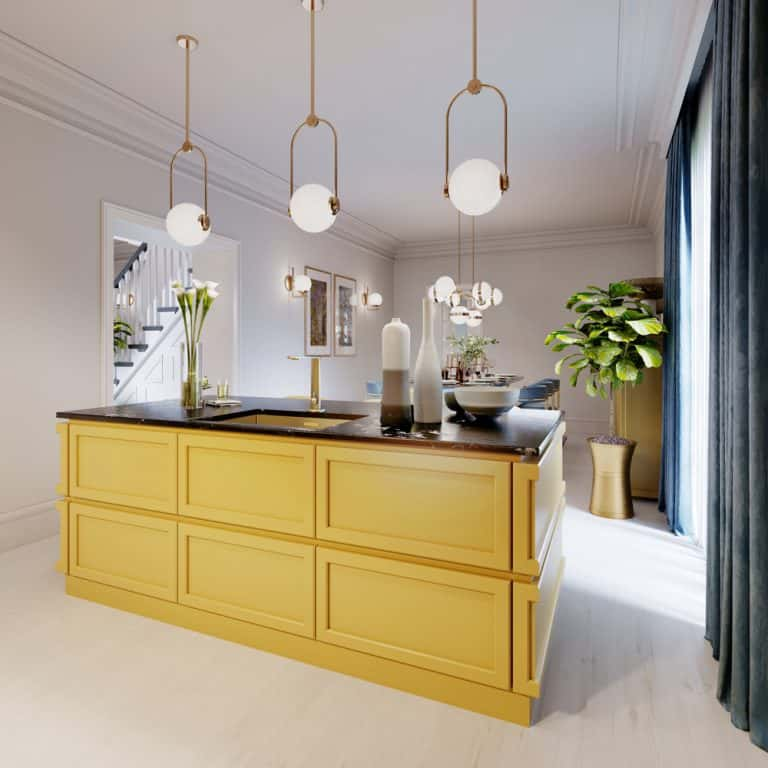
3. Task Lighting for Functionality
In order to get proper lighting in the areas where you work in the kitchen, task lights are crucial. Countertops, islands and peninsulas should be eliminated well with task light. You could also install it over the sink if you need extra lighting while washing up. Task lighting for kitchens includes under-cabinet lighting fixtures and track lighting.
If you are using task lights below the upper cabinets make sure that the internal wiring is hidden. Installing a LED kitchen strip light along the overhead storage illuminates the area in a beautiful way. How many task lights you need depends on how long the counter is. But if you don’t have many light points or want to scale down on the expense, you can pick only one or two prep zones to light up. If you want to eliminate the stove area, you can purchase a chimney with inbuilt LED lights so that you can see your food well as it is cooked.
Note: Test out the task light placement properly before installing it. If misplaced, it can cast shadows onto your work zone.
4. Lighting for Kitchen Cabinets
Cabinet lights inside let you see the contents of the cabinets easily. You can choose to make these lights switch on and off automatically when you open and close the shutter – light a refrigerator. These are particularly useful for those deep cabinets. You can either install lights in all of your cabinets or pick just a few like the corner storage. But you should identify where all you want the lighting during the planning stage so that the proper internal wiring within the carcass can be given easily.
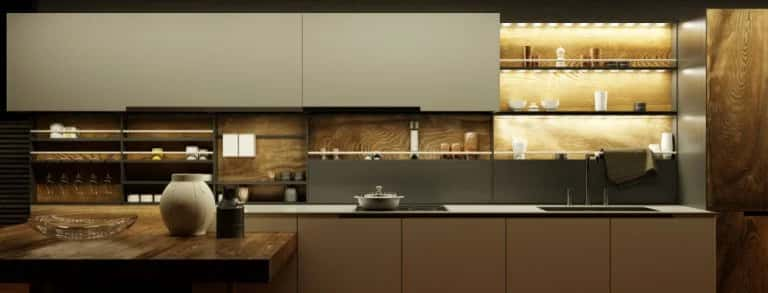
5. Accent Lighting to Set the Mood
Accent lighting should be considered as additional lights in a kitchen that’s already well-lit for functionality. It’s the cherry on the top of your well-lit kitchen. Accent lighting for kitchens comes in the form of cabinet lights, toe kick lights and any other light that helps to accentuate elements in the kitchen that you want highlighted.
They also might cross over into ambient and task lighting as well. Under-cabinet lighting, for example, can work as a task light but also as ambient light lighting with the only purpose of creating a warm glow on your kitchen counters. These can be in the form of strip lights or bar lights that runs across the bottom of your cabinets.
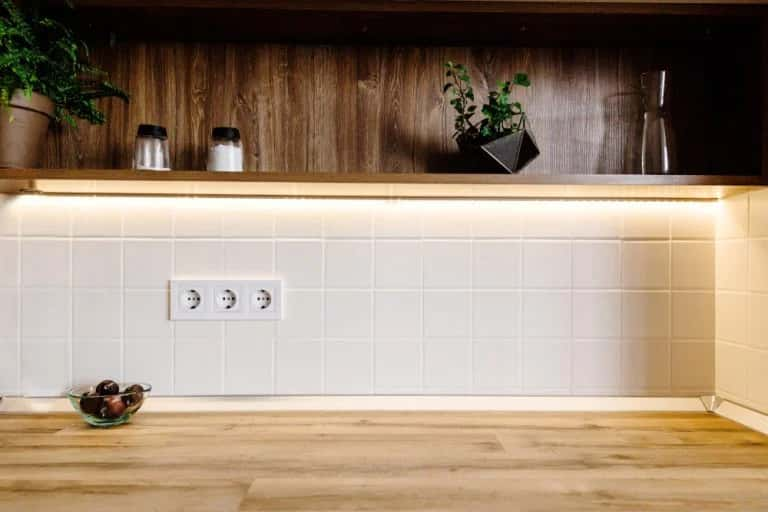
6. Tips for Kitchen Lights
A well-designed kitchen should have a combination of these lights in the right layers, working together.
Not only should the kitchen look well-lit and inviting, but the lights should be functional enough for you to prepare meals, clean, entertain guests, eat and do everything else you want without having to strain your eyes. You can also set the right mood with the right lighting, and dimmers will help with this. Dimmers will also help you save on electricity costs.
7. How much electricity are you using?
Here’s how much electricity each of these lights use:
| Type | Lumen (per sq-ft) |
LED (in watts) |
CFL (in watts) |
| General Kitchen Lighting (for a 100 sq-ft space) |
5 | 9-12W | 13-15W |
| Task Kitchen Lighting | 50 | 4-5W | 9-13W |
| Pendant Kitchen Lighting | 20 | 3-4W | 4-9W |
If you need professionals to help you choose the right lighting for your kitchen, get in touch with the HomeLane experts right away. With the experts on your side, you don’t need to worry about getting the wrong lights and then having to redo the whole thing in the future – and costing you a lot more than you should spend in the first place. Professionals will combine aesthetics with function in the right amounts.
For inspiration on kitchen designs, such as an L-shaped modular kitchen, a parallel modular kitchen, a PVC modular kitchen, a low-budget modular kitchen, an acrylic modular kitchen or even a semi-modular kitchen, head over to HomeLane.
FAQs
1. What Is the Best Lighting for a Kitchen Ceiling?
When it comes to lighting ideas for kitchen ceilings, you should think of ambient lighting options. This kind of lighting for kitchen ceilings is perfect for small/medium kitchen ceilings. You can install single or multiple flush-mount kitchen lights. Plus, you can choose from a variety of options such as flush mount, dome-shaped, or semi-flush mount variations.
2. What Size of Recessed Lighting Is Good for the Kitchen?
To install the best lighting for the kitchen, you need to use the right size of recessed lighting:
- 4-inch and 5-inch fixtures: Ideal for offering overhead countertop lighting
- 6-inch fixtures: Best for general lighting purposes
- 7- to 9-inch fixtures: Useful for creating a wider wash of light
3. What Kind of Lighting Is Best for the Kitchen?
When it comes to using the right kind of lighting for kitchens, you can take into account the following lighting ideas for kitchen:
- Surface lighting for kitchens: These are ideal for providing ambient lighting as they can be mounted directly onto the ceiling and can illuminate a larger space.
- Recessed lighting for kitchens: One of the best lighting for kitchens, you can install it directly into your ceiling, wall, or any other surface. This means that the lighting will not be exposed, making the kitchen area look larger and more open.
- Cabinet lighting for kitchens: When it comes to lighting for kitchen cabinets, you can use cabinet lights. These double up as task and accent lighting and can seamlessly offer greater visibility into your cabinets.
- Pendant lighting for kitchens: This type of lighting can be mounted to the ceiling and hangs from a chain/rod. They can illuminate spaces closer to the surface, such as a table, sink, etc.
- Lighting for kitchen island: The kitchen island lighting (such as chandeliers and pendant lighting) is essentially a kind of task light, which allows you to light up your kitchen island and engage in cooking, prep work, and more.
4. What Is the Best Light Colour for the Kitchen?
Whether you are thinking about accurate lighting for kitchen cabinets or want modern lighting for kitchens, go for the warm white shade, which ranges between 3000K to 4000K. These yellowish-white bulbs are the best colour for lighting for kitchens.
5. How Bright Should My Kitchen Lighting Be?
Ideally, the intensity of brightness for your kitchen lighting should be between 3,000 to 8,000 lumen depending on the kitchen size.

